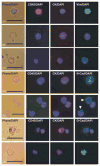Using circulating tumor cells to inform on prostate cancer biology and clinical utility
- PMID: 26079252
- PMCID: PMC4808585
- DOI: 10.3109/10408363.2015.1023430
Using circulating tumor cells to inform on prostate cancer biology and clinical utility
Abstract
Substantial advances in the molecular biology of prostate cancer have led to the approval of multiple new systemic agents to treat men with metastatic castration-resistant prostate cancer (mCRPC). These treatments encompass androgen receptor directed therapies, immunotherapies, bone targeting radiopharmaceuticals and cytotoxic chemotherapies. There is, however, great heterogeneity in the degree of patient benefit with these agents, thus fueling the need to develop predictive biomarkers that are able to rationally guide therapy. Circulating tumor cells (CTCs) have the potential to provide an assessment of tumor-specific biomarkers through a non-invasive, repeatable "liquid biopsy" of a patient's cancer at a given point in time. CTCs have been extensively studied in men with mCRPC, where CTC enumeration using the Cellsearch® method has been validated and FDA approved to be used in conjunction with other clinical parameters as a prognostic biomarker in metastatic prostate cancer. In addition to enumeration, more sophisticated molecular profiling of CTCs is now feasible and may provide more clinical utility as it may reflect tumor evolution within an individual particularly under the pressure of systemic therapies. Here, we review technologies used to detect and characterize CTCs, and the potential biological and clinical utility of CTC molecular profiling in men with metastatic prostate cancer.
Keywords: Androgen receptor; EpCAM; PSA; biomarker; castration resistant prostate cancer; liquid biopsy; microfluidic.
Conflict of interest statement
Andrew Armstrong and Mariano A. Garcia-Blanco are listed as inventors in patent applications in this field and their laboratory receives research support from Janssen Laboratories (Johnsons and Johnson) under a research agreement between Janssen and Duke University.
Figures



References
-
- Siegel R, Ma J, Zou Z, Jemal A. Cancer statistics. CA Cancer J Clin. 2014;64:9–29. - PubMed
-
- de Bono JS, Oudard S, Ozguroglu M, et al. Prednisone plus cabazitaxel or mitoxantrone for metastatic castration-resistant prostate cancer progressing after docetaxel treatment: a randomised open-label trial. Lancet. 2010;376:1147–54. - PubMed
-
- Kantoff PW, Higano CS, Shore ND, et al. Sipuleucel-T immunotherapy for castration-resistant prostate cancer. N Engl J Med. 2010;363:411–22. - PubMed
-
- Parker C, Nilsson S, Heinrich D, et al. Alpha emitter radium-223 and survival in metastatic prostate cancer. N Engl J Med. 2013;369:213–23. - PubMed
Publication types
MeSH terms
Substances
Grants and funding
LinkOut - more resources
Full Text Sources
Other Literature Sources
Research Materials
Miscellaneous
